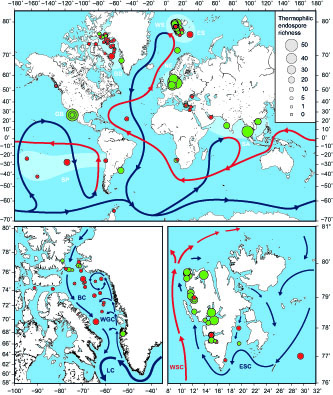Dormant microbes provide clues about passive dispersal of microorganisms in the ocean

The combined effects of passive dispersal and environmental selection influence microbial biogeography, but the contribution of either factor is difficult to discern. Inactive spores of thermophilic bacteria that are present in the cold seabed are not subject to environmental selection and thus ideal dispersal indicators (Hubert et al. 2009. Science, de Rezende et al. 2013. ISME J). These spore-forming microorganisms likely originate from hot anoxic environments in the sea floor or the ocean crust such as hydrothermal vents and their overlying sediments, or gas and oil reservoirs. We showed that individual phylotypes of thermophilic spores have various patterns of spatial distribution in the world oceans and were dispersal limited to different degrees. The overall distribution pattern of thermophilic spores suggests that the impact of passive dispersal on marine microbial biogeography is controlled by the connectivity of local water masses to ocean circulation (Müller et al. 2014. ISME J, Hanson et al. 2019. Front Microbiol).
Selected publications on this theme:
- Müller AL, de Rezende JR, Hubert C, Kjeldsen KU, Lagkouvardos I, Berry D, Jørgensen BB, Loy A. 2014. Endospores of thermophilic bacteria as tracers of microbial dispersal by ocean currents. ISME J. 8: 1153-1165.
- de Rezende JR, Kjeldsen KU, Hubert C, Finster K, Loy A, Jørgensen BB. 2013. Dispersal of thermophilic Desulfotomaculum endospores to Baltic Sea sediments over thousands of years. ISME J. 7: 72-84.
- Hubert C, Loy A, Nickel M, Arnosti C, Baranyi C, Brüchert V, Ferdelman T, Finster K, Christensen FM, Rosa de Rezende J, Vandieken V, Jørgensen BB. 2009. A constant flux of diverse thermophilic bacteria into the cold Arctic seabed. Science 325: 1541-1544.
